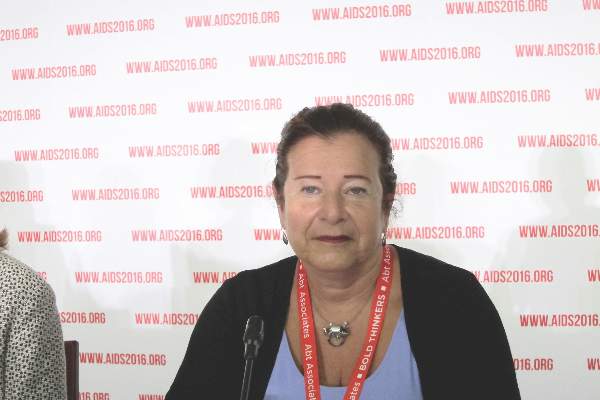AT AIDS 2016
DURBAN, SOUTH AFRICA (FRONTLINE MEDICAL NEWS) – Women who consistently used a monthly vaginal ring containing the antiretroviral drug dapivirine reduced their risk of acquiring HIV infection by 75%-91% in exploratory analyses of the phase III ASPIRE study, Elizabeth R. Brown, ScD, reported at the 21st International AIDS Conference.
ASPIRE (A Study to Prevent Infection with a Ring for Extended use), also known as the Microbicide Trials Network -020 trial, was a multicenter, randomized, double-blind, placebo-controlled, phase III trial of a silicone vaginal ring containing 25 mg of the non-nucleoside reverse transcriptase inhibitor dapivirine. ASPIRE involved 2,629 HIV-uninfected women aged 18-45 years from four Southern African countries with extremely high HIV infection rates: South Africa, Uganda, Malawi, and Zimbabwe. They were prospectively followed monthly for 12-33 months.
As reported at a conference earlier in 2016, seroconversion occurred in 71 women assigned to the dapivirine ring and 97 on a placebo ring during 4,280 person-years of follow-up. The resultant 27% relative risk reduction in an intent-to-treat analysis, while statistically significant, was less than hoped for by investigators.
However, the device only works if it’s used consistently, so the investigators decided to conduct exploratory analyses using an objective measure of adherence: the amount of dapivirine remaining in a ring after a month’s use. This was possible because the rings had been stored for analysis in a central laboratory.
The vaginal ring is self-inserted, then meant to be kept in place continuously for a month before being self-removed and replaced with a fresh ring. Dapivirine is released continuously while the ring is in place, so the less residual dapivirine contained in a used ring, the greater the adherence during that month, explained Dr. Brown , a biostatistician at the University of Washington, Seattle.
A dose-response effect was observed. In the most encouraging of the exploratory time-dependent use analyses, the rate of HIV acquisition was 4.7 cases per 100 person-years with placebo, 4.9/100 person-years in women defined as nonadherent based upon a residual dapivirine level of 23.5 mg or more, 3.1 with low use, 1.9 with moderate use, and 0.4 cases/100 person-years with consistent use as directed, meaning a patient left the device in place continuously for a month as reflected in a residual dapivirine rate below 22 mg.
This translates into a 91% reduction in risk, compared with placebo, in the most consistent users, a 58% relative risk reduction with moderate use, and a 29% reduction with low use, she continued.
The new results were hailed as a major advance in preventing HIV infection.
“We’re meeting here at AIDS 2016 in Durban, capital of the KwaZulu-Natal province of South Africa, which is one of the hardest-hit areas of the world for HIV. Over the course of their lifetime, women in Southern Africa have more than a 50% chance of HIV infection. So a new prevention tool that women can use on their own discretely to protect themselves against HIV would be a game changer,” Jared Baeten, MD, PhD, said in an interview.
“I see this as having an important potential role in the [United States] as well for women who face an increased risk of HIV. It’s extremely valuable for them to have a method of protection that they can control and feel good about and safely use for an extended period of time,” added Dr. Baeten, professor and vice chair of global health, as well as professor of allergy and infectious diseases at the University of Washington, Seattle.
The challenges involved in consistent use of the dapivirine ring are less formidable than are those posed by consistent use of a daily oral medication for preexposure prevention, he noted.
Dr. Baeten was a leader of ASPIRE and is codirector of the HOPE ( HIV Open-label Prevention Extension ) study, which is now underway. The expectation is that adherence to the dapivirine vaginal ring will be better in HOPE than in ASPIRE because participants can now be counseled that the ring works, it’s safe, and there is no chance of getting a placebo device, he said.
“There is an urgent unmet need to expand long-acting HIV prevention options for women and girls,” Zeda Rosenberg, ScD , founder and chief executive officer of the nonprofit International Partnership for Microbicides ( IPM ) in Silver Spring, Md., which is the sponsor and developer of the ring.
Toward that end, in the next several months the ASPIRE data will be combined with those from the IPM-sponsored Ring Study , another completed large phase III trial of the dapivirine ring conducted in Africa. The goals will be to try to identify potentially modifiable sociodemographic and behavioral correlates of adherence and to further strengthen the safety and efficacy findings. The plan is to submit the full data package to the Food and Drug Administration and regulat ory agencies in other countries in the spring of 2017.
“Hopefully, the product will receive marketing approval in 2018,” Dr. Rosenberg said.
In addition to sponsoring HOPE, IPM is also sponsoring the ongoing open-label DREAM (Dapivirine Ring Extended Access and Monitoring) study. IPM is also partnering with the Microbicides Trial Network to conduct a separate study of the vaginal ring in adolescents and young women in Africa.
A dapivirine vaginal ring that’s active for 3 months rather than 1 month will begin safety studies later in 2016. The potential advantages of this product are reduced annual cost and fewer clinic visits. Also, a 3-month version of the ring with an added contraceptive has been developed and will begin safety studies in the United States in fall 2016. The possibility that suboptimal adherence can be overcome by a ring containing a higher dose of dapivirine will also be explored, according to Dr. Rosenberg.
Dr. Brown, Dr. Baeten, and Dr. Rosenberg reported having no financial conflicts of interest.




